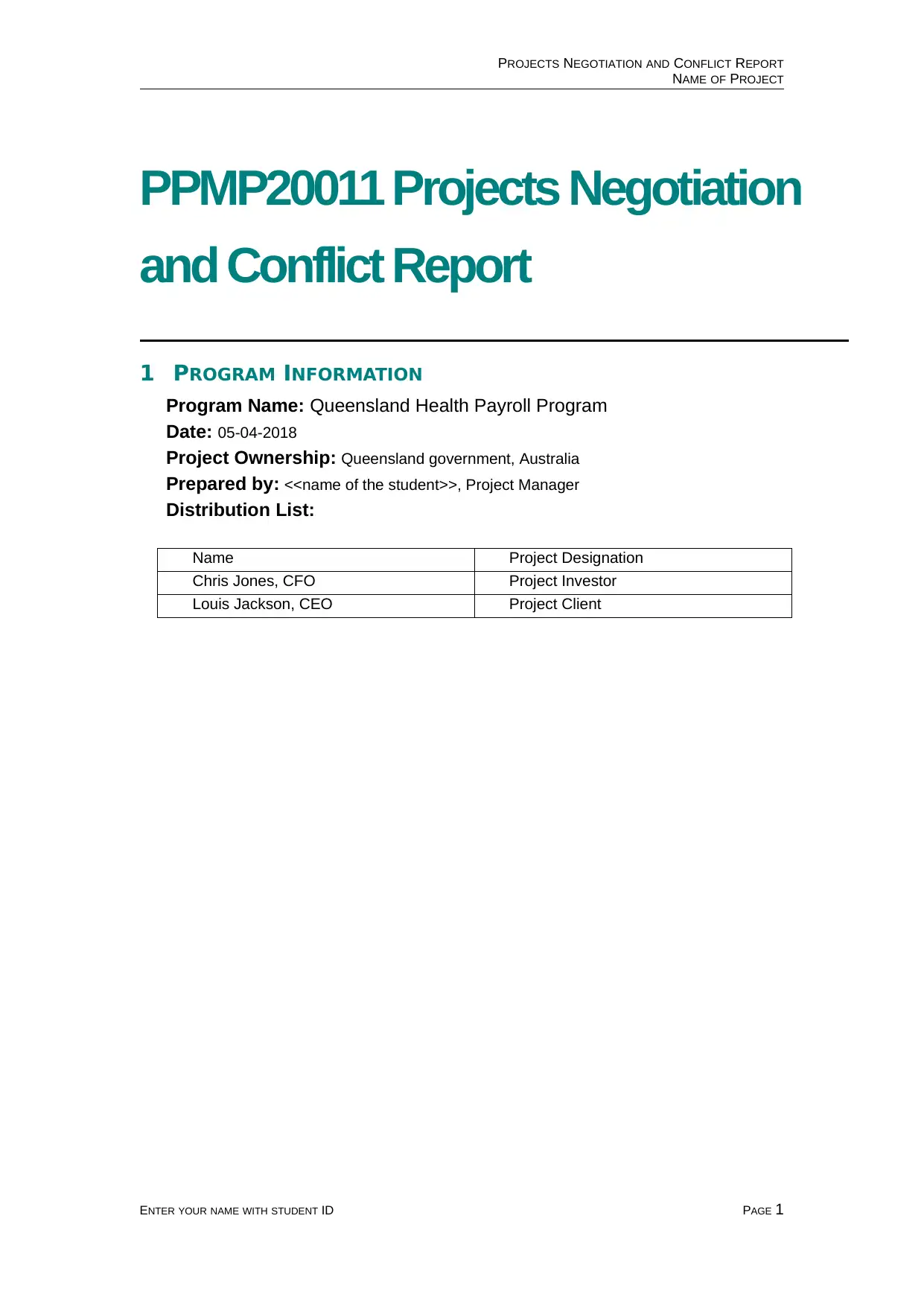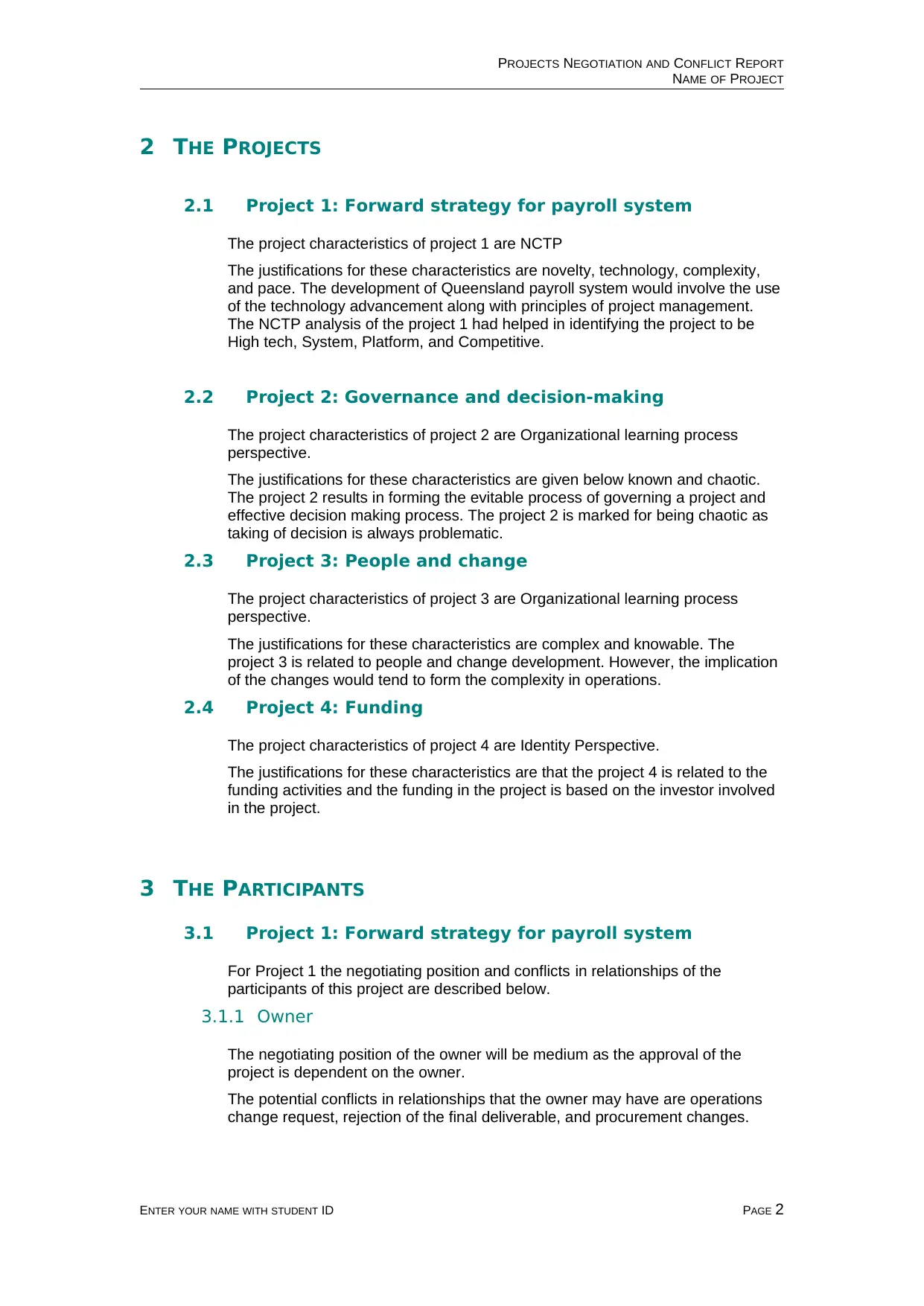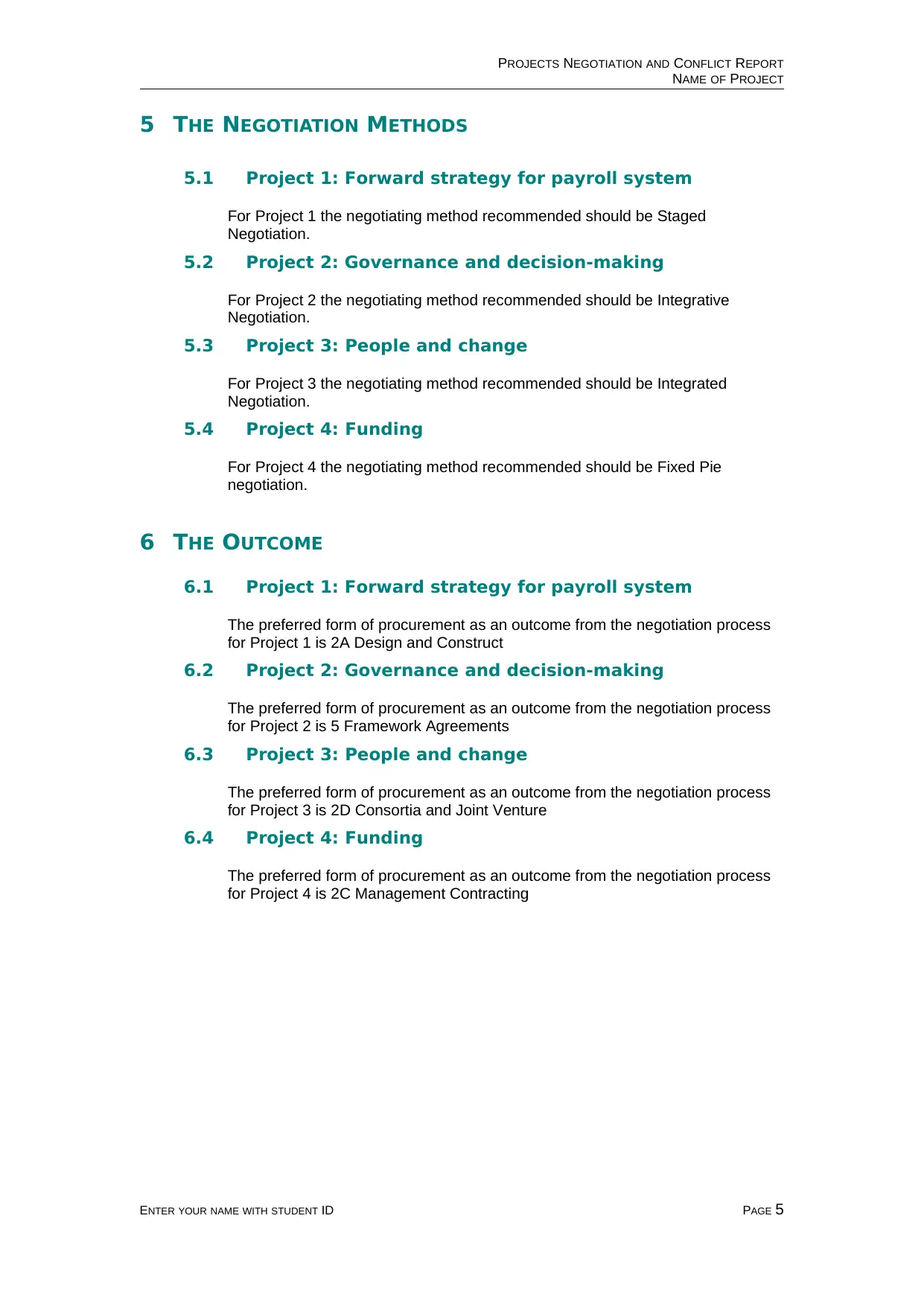Projects Negotiation and Conflict Report for Queensland Health Payroll Program
VerifiedAdded on 2023/06/13
|6
|1599
|157
AI Summary
This report discusses the negotiation positions and conflicts in relationships of the participants of four projects under the Queensland Health Payroll Program. It also recommends negotiation approaches and methods for each project.
Contribute Materials
Your contribution can guide someone’s learning journey. Share your
documents today.

PROJECTS NEGOTIATION AND CONFLICT REPORT
NAME OF PROJECT
PPMP20011 Projects Negotiation
and Conflict Report
1 PROGRAM INFORMATION
Program Name: Queensland Health Payroll Program
Date: 05-04-2018
Project Ownership: Queensland government, Australia
Prepared by: <<name of the student>>, Project Manager
Distribution List:
Name Project Designation
Chris Jones, CFO Project Investor
Louis Jackson, CEO Project Client
ENTER YOUR NAME WITH STUDENT ID PAGE 1
NAME OF PROJECT
PPMP20011 Projects Negotiation
and Conflict Report
1 PROGRAM INFORMATION
Program Name: Queensland Health Payroll Program
Date: 05-04-2018
Project Ownership: Queensland government, Australia
Prepared by: <<name of the student>>, Project Manager
Distribution List:
Name Project Designation
Chris Jones, CFO Project Investor
Louis Jackson, CEO Project Client
ENTER YOUR NAME WITH STUDENT ID PAGE 1
Secure Best Marks with AI Grader
Need help grading? Try our AI Grader for instant feedback on your assignments.

PROJECTS NEGOTIATION AND CONFLICT REPORT
NAME OF PROJECT
2 THE PROJECTS
2.1 Project 1: Forward strategy for payroll system
The project characteristics of project 1 are NCTP
The justifications for these characteristics are novelty, technology, complexity,
and pace. The development of Queensland payroll system would involve the use
of the technology advancement along with principles of project management.
The NCTP analysis of the project 1 had helped in identifying the project to be
High tech, System, Platform, and Competitive.
2.2 Project 2: Governance and decision-making
The project characteristics of project 2 are Organizational learning process
perspective.
The justifications for these characteristics are given below known and chaotic.
The project 2 results in forming the evitable process of governing a project and
effective decision making process. The project 2 is marked for being chaotic as
taking of decision is always problematic.
2.3 Project 3: People and change
The project characteristics of project 3 are Organizational learning process
perspective.
The justifications for these characteristics are complex and knowable. The
project 3 is related to people and change development. However, the implication
of the changes would tend to form the complexity in operations.
2.4 Project 4: Funding
The project characteristics of project 4 are Identity Perspective.
The justifications for these characteristics are that the project 4 is related to the
funding activities and the funding in the project is based on the investor involved
in the project.
3 THE PARTICIPANTS
3.1 Project 1: Forward strategy for payroll system
For Project 1 the negotiating position and conflicts in relationships of the
participants of this project are described below.
3.1.1 Owner
The negotiating position of the owner will be medium as the approval of the
project is dependent on the owner.
The potential conflicts in relationships that the owner may have are operations
change request, rejection of the final deliverable, and procurement changes.
ENTER YOUR NAME WITH STUDENT ID PAGE 2
NAME OF PROJECT
2 THE PROJECTS
2.1 Project 1: Forward strategy for payroll system
The project characteristics of project 1 are NCTP
The justifications for these characteristics are novelty, technology, complexity,
and pace. The development of Queensland payroll system would involve the use
of the technology advancement along with principles of project management.
The NCTP analysis of the project 1 had helped in identifying the project to be
High tech, System, Platform, and Competitive.
2.2 Project 2: Governance and decision-making
The project characteristics of project 2 are Organizational learning process
perspective.
The justifications for these characteristics are given below known and chaotic.
The project 2 results in forming the evitable process of governing a project and
effective decision making process. The project 2 is marked for being chaotic as
taking of decision is always problematic.
2.3 Project 3: People and change
The project characteristics of project 3 are Organizational learning process
perspective.
The justifications for these characteristics are complex and knowable. The
project 3 is related to people and change development. However, the implication
of the changes would tend to form the complexity in operations.
2.4 Project 4: Funding
The project characteristics of project 4 are Identity Perspective.
The justifications for these characteristics are that the project 4 is related to the
funding activities and the funding in the project is based on the investor involved
in the project.
3 THE PARTICIPANTS
3.1 Project 1: Forward strategy for payroll system
For Project 1 the negotiating position and conflicts in relationships of the
participants of this project are described below.
3.1.1 Owner
The negotiating position of the owner will be medium as the approval of the
project is dependent on the owner.
The potential conflicts in relationships that the owner may have are operations
change request, rejection of the final deliverable, and procurement changes.
ENTER YOUR NAME WITH STUDENT ID PAGE 2

PROJECTS NEGOTIATION AND CONFLICT REPORT
NAME OF PROJECT
3.1.2 Designers
The negotiating position of the designers will be high as the payroll system
design is dependent on the designer.
The potential conflicts in relationships that the designers may have are design
function issues and feasibility issue in the system.
3.1.3 Contractors
The negotiating position of the contractors will be low as the contractor is only
required for the alignment of the external operations of the project.
The potential conflicts in relationships that the contractors may have are contract
violation and delay in support operations.
3.2 Project 2: Governance and decision-making
For Project 2 the negotiating position and conflicts in relationships of the
participants of this project are described below.
3.2.1 Owner
The negotiating position of the owner will be high as the owner plays a key role
in the development of project governance and making key decisions of the
project.
The potential conflicts in relationships that the owner may have are
unacceptance in design and changes required for design.
3.2.2 Designers
The negotiating position of the designers will be low as decision making is not
consulted with the designer.
The potential conflicts in relationships that the designers may have are forging in
decision and design incompatible.
3.2.3 Contractors
The negotiating position of the contractors will be medium as the decisions of the
project are dependent on the supply from external contractors.
The potential conflicts in relationships that the contractors may have are
obligations, and payment issues.
3.3 Project 3: People and change
For Project 3 the negotiating position and conflicts in relationships of the
participants of this project are described below.
3.3.1 Owner
The negotiating position of the owner will be high as the owner would be
responsible for the change implication in the project
The potential conflicts in relationships that the owner may have are alteration in
project objectives, person attrition, and change deployment issues.
3.3.2 Designers
The negotiating position of the designers will be low as they are required only for
design development and operations.
The potential conflicts in relationships that the designers may have are
complexity in design and denial of acceptance.
ENTER YOUR NAME WITH STUDENT ID PAGE 3
NAME OF PROJECT
3.1.2 Designers
The negotiating position of the designers will be high as the payroll system
design is dependent on the designer.
The potential conflicts in relationships that the designers may have are design
function issues and feasibility issue in the system.
3.1.3 Contractors
The negotiating position of the contractors will be low as the contractor is only
required for the alignment of the external operations of the project.
The potential conflicts in relationships that the contractors may have are contract
violation and delay in support operations.
3.2 Project 2: Governance and decision-making
For Project 2 the negotiating position and conflicts in relationships of the
participants of this project are described below.
3.2.1 Owner
The negotiating position of the owner will be high as the owner plays a key role
in the development of project governance and making key decisions of the
project.
The potential conflicts in relationships that the owner may have are
unacceptance in design and changes required for design.
3.2.2 Designers
The negotiating position of the designers will be low as decision making is not
consulted with the designer.
The potential conflicts in relationships that the designers may have are forging in
decision and design incompatible.
3.2.3 Contractors
The negotiating position of the contractors will be medium as the decisions of the
project are dependent on the supply from external contractors.
The potential conflicts in relationships that the contractors may have are
obligations, and payment issues.
3.3 Project 3: People and change
For Project 3 the negotiating position and conflicts in relationships of the
participants of this project are described below.
3.3.1 Owner
The negotiating position of the owner will be high as the owner would be
responsible for the change implication in the project
The potential conflicts in relationships that the owner may have are alteration in
project objectives, person attrition, and change deployment issues.
3.3.2 Designers
The negotiating position of the designers will be low as they are required only for
design development and operations.
The potential conflicts in relationships that the designers may have are
complexity in design and denial of acceptance.
ENTER YOUR NAME WITH STUDENT ID PAGE 3

PROJECTS NEGOTIATION AND CONFLICT REPORT
NAME OF PROJECT
3.3.3 Contractors
The negotiating position of the contractors will low as they do not play a role for
managing the people or changes in project.
The potential conflicts in relationships that the contractors may have are rejection
of association and issues in communication deliverable.
3.4 Project 4: Funding
For Project 4 the negotiating position and conflicts in relationships of the
participants of this project are described below.
3.4.1 Owner
The negotiating position of the owner will be high as the owner is in charge of the
funding operations for the project.
The potential conflicts in relationships that the owner may have are funding
rejection, unable to access funds, and shortage of payment.
3.4.2 Designers
The negotiating position of the designers will be low as funding does not depend
on the designer.
The potential conflicts in relationships that the designers may have are not
feasible design development and payment issues.
3.4.3 Contractors
The negotiating position of the contractors will be medium as funding would have
to consider the supplied material costs by the contractor.
The potential conflicts in relationships that the contractors may have are
undesired quality of material and price hike of materials.
4 THE NEGOTIATION INTERACTION PROCESS
4.1 Project 1: Forward strategy for payroll system
For Project 1 the negotiating position recommended should be structural
approach in nature.
4.2 Project 2: Governance and decision-making
For Project 2 the negotiating position recommended should be strategic
approach in nature
4.3 Project 3: People and change
For Project 3 the negotiating position recommended should be behavioural
approach in nature.
4.4 Project 4: Funding
For Project 4 the negotiating position recommended should be integrative
approach in nature.
ENTER YOUR NAME WITH STUDENT ID PAGE 4
NAME OF PROJECT
3.3.3 Contractors
The negotiating position of the contractors will low as they do not play a role for
managing the people or changes in project.
The potential conflicts in relationships that the contractors may have are rejection
of association and issues in communication deliverable.
3.4 Project 4: Funding
For Project 4 the negotiating position and conflicts in relationships of the
participants of this project are described below.
3.4.1 Owner
The negotiating position of the owner will be high as the owner is in charge of the
funding operations for the project.
The potential conflicts in relationships that the owner may have are funding
rejection, unable to access funds, and shortage of payment.
3.4.2 Designers
The negotiating position of the designers will be low as funding does not depend
on the designer.
The potential conflicts in relationships that the designers may have are not
feasible design development and payment issues.
3.4.3 Contractors
The negotiating position of the contractors will be medium as funding would have
to consider the supplied material costs by the contractor.
The potential conflicts in relationships that the contractors may have are
undesired quality of material and price hike of materials.
4 THE NEGOTIATION INTERACTION PROCESS
4.1 Project 1: Forward strategy for payroll system
For Project 1 the negotiating position recommended should be structural
approach in nature.
4.2 Project 2: Governance and decision-making
For Project 2 the negotiating position recommended should be strategic
approach in nature
4.3 Project 3: People and change
For Project 3 the negotiating position recommended should be behavioural
approach in nature.
4.4 Project 4: Funding
For Project 4 the negotiating position recommended should be integrative
approach in nature.
ENTER YOUR NAME WITH STUDENT ID PAGE 4
Secure Best Marks with AI Grader
Need help grading? Try our AI Grader for instant feedback on your assignments.

PROJECTS NEGOTIATION AND CONFLICT REPORT
NAME OF PROJECT
5 THE NEGOTIATION METHODS
5.1 Project 1: Forward strategy for payroll system
For Project 1 the negotiating method recommended should be Staged
Negotiation.
5.2 Project 2: Governance and decision-making
For Project 2 the negotiating method recommended should be Integrative
Negotiation.
5.3 Project 3: People and change
For Project 3 the negotiating method recommended should be Integrated
Negotiation.
5.4 Project 4: Funding
For Project 4 the negotiating method recommended should be Fixed Pie
negotiation.
6 THE OUTCOME
6.1 Project 1: Forward strategy for payroll system
The preferred form of procurement as an outcome from the negotiation process
for Project 1 is 2A Design and Construct
6.2 Project 2: Governance and decision-making
The preferred form of procurement as an outcome from the negotiation process
for Project 2 is 5 Framework Agreements
6.3 Project 3: People and change
The preferred form of procurement as an outcome from the negotiation process
for Project 3 is 2D Consortia and Joint Venture
6.4 Project 4: Funding
The preferred form of procurement as an outcome from the negotiation process
for Project 4 is 2C Management Contracting
ENTER YOUR NAME WITH STUDENT ID PAGE 5
NAME OF PROJECT
5 THE NEGOTIATION METHODS
5.1 Project 1: Forward strategy for payroll system
For Project 1 the negotiating method recommended should be Staged
Negotiation.
5.2 Project 2: Governance and decision-making
For Project 2 the negotiating method recommended should be Integrative
Negotiation.
5.3 Project 3: People and change
For Project 3 the negotiating method recommended should be Integrated
Negotiation.
5.4 Project 4: Funding
For Project 4 the negotiating method recommended should be Fixed Pie
negotiation.
6 THE OUTCOME
6.1 Project 1: Forward strategy for payroll system
The preferred form of procurement as an outcome from the negotiation process
for Project 1 is 2A Design and Construct
6.2 Project 2: Governance and decision-making
The preferred form of procurement as an outcome from the negotiation process
for Project 2 is 5 Framework Agreements
6.3 Project 3: People and change
The preferred form of procurement as an outcome from the negotiation process
for Project 3 is 2D Consortia and Joint Venture
6.4 Project 4: Funding
The preferred form of procurement as an outcome from the negotiation process
for Project 4 is 2C Management Contracting
ENTER YOUR NAME WITH STUDENT ID PAGE 5

PROJECTS NEGOTIATION AND CONFLICT REPORT
NAME OF PROJECT
7 BIBLIOGRAPHY
Dorochoff, N. (2016). Negotiation Basics for Cultural Resource Managers.
Routledge.
Jones, S., Jeffrey, S., Maxwell, M., Hale, A., & Jones, C. (2018). 3D heritage
visualisation and the negotiation of authenticity: the ACCORD project.
International Journal of Heritage Studies, 24(4), 333-353.
Li, C. C., Wu, L., Li, C., & Tang, J. (2017). Exploring meaning negotiation
patterns in synchronous audio and video conferencing English classes in
China. CALL in a climate of change: adapting to turbulent global
conditions–short papers from EUROCALL 2017, 194.
Raby, R. (2018). Using the International Negotiation Modules Project (INMP) to
Build a Learning Community. In Student Engagement and Participation:
Concepts, Methodologies, Tools, and Applications (pp. 652-666). IGI
Global.
Wang, Q., Kilgour, D. M., & Hipel, K. W. (2015). Facilitating risky project
negotiation: An integrated approach using fuzzy real options, multicriteria
analysis, and conflict analysis. Information Sciences, 295, 544-557.
Wolff, R. (2015). Book Review: Private Dispute Resolution in International
Business: Negotiation, Mediation, Arbitration, 3rd edn, by Klaus Peter
Berger.(Wolters Kluwer, 2015). Journal of International Arbitration, 32(6),
711-713.
ENTER YOUR NAME WITH STUDENT ID PAGE 6
NAME OF PROJECT
7 BIBLIOGRAPHY
Dorochoff, N. (2016). Negotiation Basics for Cultural Resource Managers.
Routledge.
Jones, S., Jeffrey, S., Maxwell, M., Hale, A., & Jones, C. (2018). 3D heritage
visualisation and the negotiation of authenticity: the ACCORD project.
International Journal of Heritage Studies, 24(4), 333-353.
Li, C. C., Wu, L., Li, C., & Tang, J. (2017). Exploring meaning negotiation
patterns in synchronous audio and video conferencing English classes in
China. CALL in a climate of change: adapting to turbulent global
conditions–short papers from EUROCALL 2017, 194.
Raby, R. (2018). Using the International Negotiation Modules Project (INMP) to
Build a Learning Community. In Student Engagement and Participation:
Concepts, Methodologies, Tools, and Applications (pp. 652-666). IGI
Global.
Wang, Q., Kilgour, D. M., & Hipel, K. W. (2015). Facilitating risky project
negotiation: An integrated approach using fuzzy real options, multicriteria
analysis, and conflict analysis. Information Sciences, 295, 544-557.
Wolff, R. (2015). Book Review: Private Dispute Resolution in International
Business: Negotiation, Mediation, Arbitration, 3rd edn, by Klaus Peter
Berger.(Wolters Kluwer, 2015). Journal of International Arbitration, 32(6),
711-713.
ENTER YOUR NAME WITH STUDENT ID PAGE 6
1 out of 6
Related Documents
Your All-in-One AI-Powered Toolkit for Academic Success.
+13062052269
info@desklib.com
Available 24*7 on WhatsApp / Email
![[object Object]](/_next/static/media/star-bottom.7253800d.svg)
Unlock your academic potential
© 2024 | Zucol Services PVT LTD | All rights reserved.

